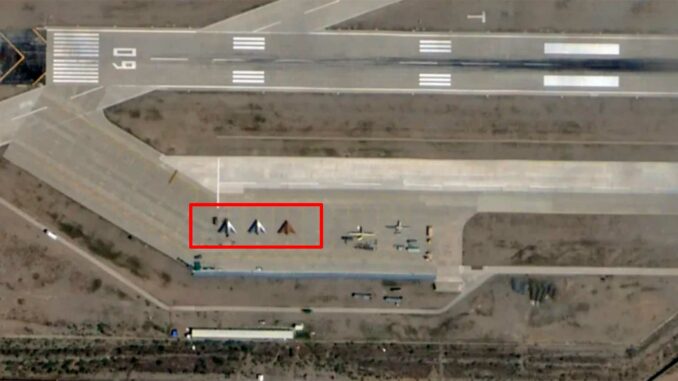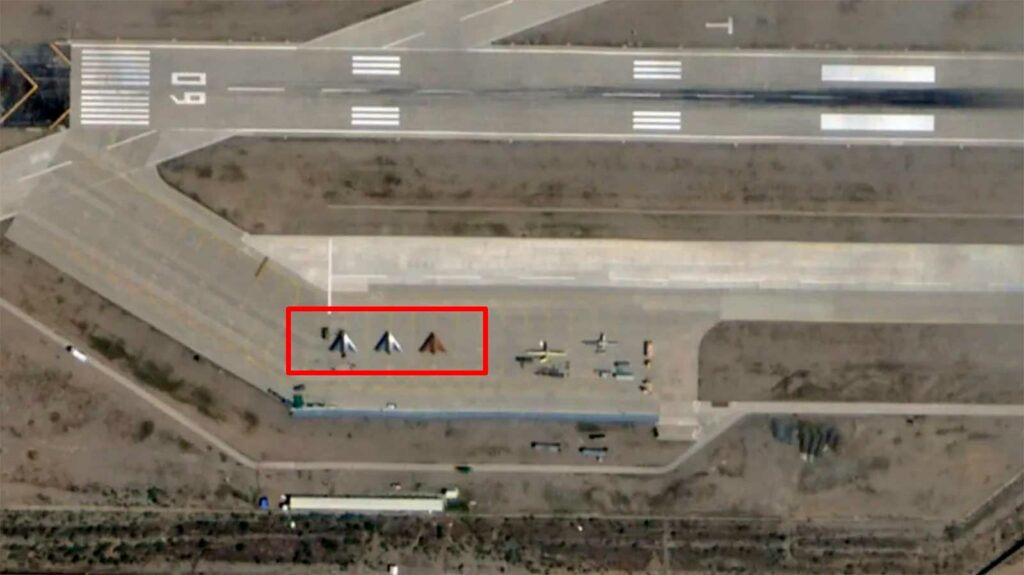
The GJ-11 Sharp Sword operates from Shigatse: capabilities, use against India, role with the J-20S, and China’s rise in stealth UCAVs, figures and analysis.
Understand in 2 minutes
Recent satellite images show at least three GJ-11 Sharp Swords stationed for several weeks at Shigatse, a mixed air base in Tibet near the Sino-Indian border. This prolonged presence suggests an advanced operational testing phase, or even initial commissioning. The GJ-11, a stealth flying wing, is designed for deep penetration (air-to-ground strike, ISR), electronic warfare support and, ultimately, collaborative air-to-air combat. Shigatse, perched at 3,782 m, offers demanding “high altitude” conditions, a 5,000 m main runway, and expanding infrastructure. The base already hosts strategic sensors such as the WZ-7 Soaring Dragon, useful for designating targets beyond the horizon. The pairing with the two-seater J-20S, designed for piloting drones, embodies China’s rapidly maturing manned-unmanned teaming. At the same time, a shipborne variant of the GJ-11 is being studied for aircraft carriers and assault ships, a sign of joint integration. Strategically, Beijing is equipping itself with a range of stealth UCAVs, while Washington remains publicly discreet on this segment. The result is sustained pressure on India’s air superiority and a regional rebalancing at altitude.
Deployment in Shigatse: tests that resemble operational use
Commercial photographs from the summer of 2025 show three GJ-11 Sharp Sword aircraft in Shigatse from August 6 to September 5, then two aircraft still visible in early September. A presence lasting several weeks goes beyond simple ground validation: it involves flight cycles, maintenance, and tactical evaluation in a realistic environment. The airframes observed feature the standard gray livery of Chinese platforms, with another protected by a reddish-brown cover, indicating short-term storage and aircraft rotation. The choice of Shigatse is not insignificant: the base, which is very active, is already a drone hub and hosts a continuous fighter presence (the “Flanker” family, J-10), as well as early warning aircraft and helicopters. It is located approximately 145 km from Sikkim, an area that has been sensitive to Sino-Indian clashes since 2020. The installation of stealth UCAVs within direct range of these sectors suggests the evaluation of real-world employment patterns: covert penetration, precision strikes, jamming of enemy radar illumination, and long-persistence ISR collection. This “staging” at altitude reduces the gap between the laboratory and the front line and accelerates adoption by units.
Shigatse infrastructure: extreme altitude, 5,000 m runway and extension
Shigatse (RKZ/ZURK) has three technical advantages: an altitude of 3,782 m (12,408 ft), a 5,000 m concrete main runway, and an auxiliary runway of approximately 3,000 m built around 2017 with seven large aircraft parking stands. The altitude requires longer takeoff distances, reduced thrust margins, and rigorous thermal management, making it ideal for testing the mission profiles of heavy drones. Recent expansion work to the east (enlarged apron, at least five hangars, support buildings) confirms an increase in capacity. Historically militarized, the infrastructure was opened to civilian traffic in 2010 after an investment of 532 million yuan, or approximately €69 million at the current average exchange rate, which has promoted dual use and densification of activities. For operational planning, two runways, large aprons, and dedicated shelters allow for alternating test flights, fighter QRA, and drone operations without saturation. This redundancy increases resilience to denial strikes. Finally, the remoteness of Indian high-mountain logistics chains gives any ISR patrol departing from Shigatse a time-on-area advantage.
The GJ-11’s mission: penetration, ISR, and electronic warfare
The GJ-11 Sharp Sword is a medium-sized stealth flying wing, optimized for reduced radar cross-section (RCS), in-fuselage weapons carriage, and subsonic endurance. Its primary purpose is deep penetration for air-to-ground strikes in contested environments, complemented by strategic ISR (imagery, signals) and electronic warfare effects: masking, deception, and degradation of enemy communications. In Shigatse, these profiles are credible: multi-layered Indian defense (Akash, SPYDER, Barak-8, high-altitude radars) at varying distances, complex weather, terrain generating multiple lobes—useful terrain for validating flight envelopes and low-signature approach procedures. The iterations observed in 2024-2025 (Malan, Changxing, parades with models and prototypes) reflect a stabilization of the stealth configuration unveiled in 2019 and the transition to series standards. In a typical operational scenario, the GJ-11 leads the way, neutralizes sensors, delivers guided munitions, and then holds the ISR bubble for the information battle. The goal is to reduce the exposure of manned fighters and create local windows of opportunity.
Teaming with the J-20S: a collaborative leap in capability
The two-seat J-20S is not just a training aircraft: its second seat handles data fusion, electronic warfare, and drone control. In a manned-unmanned teaming scheme, a J-20S crew directs a pack of UCAVs: role distribution (decoy, jammer, striker), secure link management, multi-spectrum target designation. Chinese audiovisual reports have already shown footage of J-20/GJ-11 interaction. Operating this in Shigatse makes it possible to test the robustness of links in high mountains, the latency induced by the terrain, and the performance of network-centric antennas in extreme cold, all of which are critical elements for credible deployment along the Sino-Indian border. At the doctrinal level, the ability to engage multiple drones from a J-20S creates economies of scale: fewer human entries into the A2/AD zone, greater persistence, and targeted saturation of radars and surface-to-air batteries. On the Indian side, this requires a denser layered defense, additional passive sensors, and tighter joint coordination to avoid exhausting surface-to-air munitions in the face of swarms mixing decoys and armed vectors.

The base as an ISR hub: contribution of the WZ-7 Soaring Dragon
Shigatse permanently hosts the WZ-7 Soaring Dragon, a diamond-shaped HALE drone designed for reconnaissance and potentially for providing long-range targeting data. Its endurance and ceiling allow it to monitor beyond the Himalayan peaks and track logistical movements. Combined with the GJ-11, this sensor provides the “big picture” while the UCAV conducts stealth operations in the valleys. This sensor-effector complementarity results in a shortened ISR-Strike cycle: detection, classification, assignment, strike, damage assessment, all with minimal human exposure. In practice, the WZ-7/J-20S/GJ-11 network promotes the disorganization of the enemy’s air defense: jamming of priorities, saturation of screens with fragmented tracks, and temptations to fire prematurely, consuming costly missiles. For New Delhi, the answer lies in passive sensors based on listening (ELINT/COMINT) and multi-site redundancy in order to reconstruct the situation without relying on a single radar. The exercises in Shigatse validate exactly this type of network, placing strategic and tactical drones on the same platform.
The shipborne variant: towards the naval extension of the GJ-11
Evidence is mounting for a naval variant of the GJ-11 (often referred to as GJ-11H/GJ-11J/GJ-21): industrial concepts showing foldable wings and operations from assault ships, models visible at the Wuhan test site or the Changxing site, and naval air power build-up with J-35, J-15T, and KJ-600. This trajectory suggests future integration on catapult-equipped aircraft carriers and multi-purpose ships, in order to provide penetrating ISR, electronic warfare, and strikes on the first day of a conflict in the China Sea. In terms of logistics, a common land/sea airframe will reduce life-cycle costs (same computers, software, derived sensors), although adaptation to flight deck constraints (corrosion, catapults, landing, tail hook, reinforced landing gear) will increase the unit cost. By 2027-2030, the emergence of an operational capability—even a limited one—would create a new strategic maritime depth for Beijing, with a direct link between the carrier strike group and the Himalayan theater via ISR relays and communications constellations.
The strategic consequences for India and the region
The shift towards swarms of stealth drones controlled by modern fighters requires India to adapt quickly. From a technical point of view, air defense will have to focus on: multipoint passive sensors, low-frequency radars (VHF/UHF) to detect flying wings, optical-IR networks on ridges, and multi-sensor fusion to discriminate between decoys and real vectors. On the firepower side, the use of low-cost surface-to-air missiles against small SERs is becoming essential in order to avoid depleting stocks of high-end missiles. At the operational level, AI for runway sorting, ammunition stocks at altitude, and protected logistics routes will be the key variables; it is prosaic, but decisive in the face of aerial attrition campaigns.
For Beijing, the advantage lies in industrial density: production rate, rapid iterations, and stacking of families (GJ-11, WZ-7, CH-series, large “flying wings” observed in Malan in 2025). Constant pressure over the Himalayas, carried by low-signature vectors, broadens the coercive arsenal without immediately crossing lethal thresholds. The message is clear: impose tactical facts through presence and restraint. Washington, publicly absent from the stealth UCAV segment since the discontinuation of previous programs, leaves media space to Beijing. it would be naive to conclude that this is due to American inaction, but on the visible stage, the momentum is Chinese. New Delhi, for its part, would benefit from accelerating its C2 (IACCS) programs, its high-altitude radars, and its sensor-effect partnerships with France or Israel.
Market data and the cost equation
There is little reliable public information on the unit cost of the GJ-11. As a proxy, we can look at investment in infrastructure: the civilian opening of Shigatse mobilized CNY 532 million (≈ €69 million) in 2010, while recent images confirm substantial military extensions (new areas, hangars). The marginal cost of a several-week test deployment includes the ground segment (shelters, links, ECM), the mission chain (stations, encryption), and flight hours to validate profiles and software. The choice of a mixed hub optimizes access costs (fuel, shared MRO). Based on Western experience, manned-unmanned teaming integration represents a significant portion of the budget—links and data fusion are sometimes as valuable as the airframe. In contrast, on the Indian side, each multi-layered defense reinforcement in high mountains is costly (transport, human density, high-value ammunition). Ultimately, the asymmetry between “attack cost” and “defense cost” could be reversed if New Delhi does not introduce low-cost layers (passive sensors, inexpensive ground-to-air C-RAM ammunition, decoys).
War Wings Daily is an independant magazine.